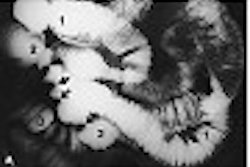CHICAGO - A three-minute MRI examination for acute stroke patients is not only feasible, it provides critical information that can help doctors treat these patients, researchers said at the 2003 RSNA meeting.
"The ultrafast imaging results in a win-win situation for doctors and patients," said Dr. Jonathan Gillard, lecturer in neuroradiology at the University of Cambridge in England.
Gillard cited several
advantages to the three-minute MRI protocol studied by his group:
- The images are clearer,
cover the entire head and have the potential to affect treatment decisions by
providing blood vessel information that the doctor can use in considering
therapy.
- The claustrophobia
experienced by patients -- already frightened and nervous because of their
acute stroke symptoms -- can be alleviated by a shorter time period in the scanner.
- The quick time required to
perform the MRI study in the stroke patients makes hospital scheduling easier
for radiology departments.
"The previous MRI studies would take 20 minutes or longer," Gillard explained, "and that could mess up the scheduling in the department." He said that at his institution -- where the 3-minute test is now performed routinely -- the radiology staff has no problem allowing the quick tests on acute stroke patients.
Because of the time required for conventional MRI, Gillard said doctors had gravitated towards using CT to determine if the patient was a candidate for the use of thrombolytic therapy by analyzing cerebral blood flow and cerebral blood volume. Gillard said the ultrafast MRI can provide additional information, including MR angiography that can determine if there still is an arterial blockage that needs to be lysed.
He said doctors planning thrombolytic stroke therapy need to know if the patient is within the time window for therapy, usually three hours from the onset of symptoms; if there is still a clot blocking blood flow to the brain, since in 40% of cases the clot dissolves spontaneously; and if the blood vessels beyond the clot are viable or carry a greater risk of hemorrhage upon reperfusion.
All that information is available using the ultrafast technology. Although most of the information is available in the 3-minute scan, Gillard said that in practice the scan is usually continued for five minutes to gather blood flow data.
The Cambridge unit is able to perform the studies because it has access to an 8-antenna array head coil developed by General Electric. Similar arrays are being developed by other manufacturers, Gillard said, and are being rolled out as demanded by institutions.
"Generally, I think that MR and CT are producing comparable results in stroke," Gillard said at a press briefing. "We prefer the MR at Cambridge." He said he expects the ultrafast MR to become the imaging approach of choice in evaluating stroke patients for possible thrombolytic therapy.
In Gillard’s study, 24 acute stroke patients were scanned using both the longer MR exam and the ultrafast approach, administered in random order. He observed clearer pictures with the shorter scan -- less motion artifact, and important additional information regarding arterial anatomy and clot position.
"It is possible to undertake an integrated MR examination of acute stroke patients in three minutes," he said. "Including a perfusion sequence will add a further 90 seconds to this protocol; this duration being limited by physiological factors rather than technological advances. Ultrafast imaging has the potential to become a useful triage tool prior to the administration of thrombolytic therapy. It may be of particular benefit in patients unable to tolerate longer sequences."
By Edward Susman
AuntMinnie.com contributing writer
December 2, 2003
Copyright © 2003 AuntMinnie.com


.fFmgij6Hin.png?auto=compress%2Cformat&fit=crop&h=100&q=70&w=100)





.fFmgij6Hin.png?auto=compress%2Cformat&fit=crop&h=167&q=70&w=250)











